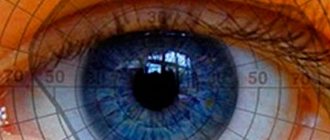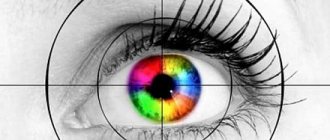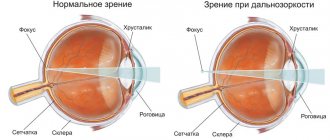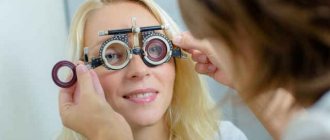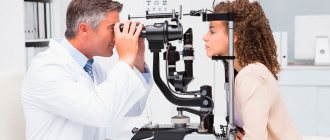- Progressive - due to stretching of the back of the eye, myopia gradually increases. Often myopia, which progresses in childhood and adolescence, stabilizes at the age of 20-30 years. Continuously progressive myopia, reaching high values (30-40 D), with complications, is called myopic disease, or malignant myopia;
- Non-progressive - more favorable course, easier to correct;
- False (spastic, pseudomyopia) - myopia that occurs with an increase in the tone of the ciliary muscle (spasm of accommodation) and resolves with its normalization;
- Transient myopia is sometimes considered as a type of false myopia; it develops with concomitant somatic pathology (diabetes mellitus) and when taking a number of medications (sulfonamides, isoniazid). Usually amenable to correction.
- Congenital myopia is associated with abnormalities in the development of the eyeball and manifests itself from birth. Rarely encountered;
- Axial - develops when the optical axis of the eye is long;
- Refractive (optical) - caused by excessive refractive power of the optical system of the eye;
- Combined myopia is usually of a small degree; the refractive power of the optical system of the eye and the length of its optical axis do not exceed normal values, but the combination of parameters does not provide normal refraction;
- Night (twilight) - associated with changes in the refraction of the eye in conditions of lack of light. Allowed with increasing illumination.
Classification of myopia by type of refractive error
Complications
Pregnancy and childbirth with 2nd degree myopia
Natural delivery is contraindicated for moderate and high myopia. Pushing during childbirth can negatively affect vision, especially if there is retinal dystrophy. As a rule, to eliminate ophthalmological risks, cesarean section is recommended for pregnant women with high myopia. The condition of the retina in the last trimester, as well as dynamic observation by an ophthalmologist throughout pregnancy, allows you to make a final decision on the method of delivery.
If the entire pregnancy proceeded without complications, the condition of the eye structures is stable and there are no significant changes in the fundus, natural childbirth is acceptable. The final decision on this is made by the obstetrician-gynecologist, based on the results of the observations of the ophthalmologist.
If there is a risk of rupture and detachment of the retina, trophic degenerative changes developed during pregnancy, and myopia progressed, the natural method of pushing during childbirth carries a high probability of significant loss of vision and even blindness.
Prevention of development/progression of myopia
- Compliance with visual hygiene standards (proper lighting, adequate distance from objects when working, reading, absence of excessive loads);
- Walking and moderate physical activity in the fresh air;
- Correct correction of myopia. A number of studies have revealed the positive effect of partial vision correction compared with full correction in slowing the progression of the disease;
- Performing exercises to train the muscular system, especially in childhood and adolescence;
- A number of studies discuss the possibility of using atropine and other muscarinic receptor antagonists to prevent the progression of myopia;
- For existing myopia, a gentle regimen with limited physical activity (depending on the degree of myopia) and limited visual stress is indicated, especially with high myopia.
Moderate myopia in children.
Myopia in children can be hereditary or acquired. In the first case, you should especially carefully monitor the vision of children whose parents suffer from myopia. The probability of transmitting the pathology by inheritance is very high.
If myopia is not genetically determined, it can develop as a result of excessive stress (during study and other activities that strain the visual organs). The background for the weakening of the eye structures can be violations of the exercise and rest regime, monotonous nutrition, deficiency of vitamins and protein foods, uncontrolled watching of TV and working at a computer monitor.
Myopia in children of any origin is most often detected at the age of 7-10 years. This coincides with the start of school, which is a major risk factor.
Myopia of any degree can usually be corrected with glasses or contact lenses. In the case of children, glasses are most convenient, since the child cannot yet use lenses independently and maintain hygiene and wearing them. Glasses are prescribed only by an ophthalmologist. During a visit to the ophthalmologist, the child undergoes a series of studies that provide the doctor with the necessary information about the degree of myopia, the nature and dynamics of its course, and the general condition of the patient. Only by taking into account all these factors is it possible to choose glasses that will not only correct vision, but also not cause harm. In no case should you select glasses without visiting an ophthalmologist and the participation of an experienced doctor. Only a specialist can correctly assess the degree of myopia and prescribe glasses taking into account the child’s visual needs. When ordering glasses, the comfort of the frame is also important for a child. Glasses should not be heavy. Considering children's mobility, you need to make sure that they fit tightly enough, but do not squeeze the temples.
Unlike adults, who are recommended to constantly wear glasses for moderate myopia, children are allowed to wear distance glasses only when necessary (for example, in class, when they need to look at the blackboard). Only with large values of myopia or with its progression is it recommended for the child to constantly wear glasses (when writing and reading, working at the computer, while playing or walking).
In such a situation, if you stop wearing glasses, the child begins to bring the book close to his eyes while reading. This further aggravates muscle tension, causes eye fatigue and contributes to the further development of pathology. In addition, such proximity of the objects in question causes general discomfort and fatigue. The child’s performance decreases; he may even begin to refuse some homework or skip classes, which will reduce his performance at school.
Starting to wear glasses for a child can be associated with some discomfort and requires getting used to. The adaptation period varies for different children and depends on the general condition, motivation and other factors. Here the role of parents is great, they must explain to the child the appropriateness of this device and talk about the possible negative consequences of giving up glasses. Sometimes, during the adjustment period, glasses with smaller diopters are prescribed, which do not provide complete correction, but allow the child to get used to new conditions.
There is an opinion among some parents that glasses only harm and contribute to the development of myopia, since the eye muscles “do not work.” This is not true. It is the tension that occurs during myopia that contributes to its further development. Glasses allow the structures of the eye to work in a similar way to what happens in healthy eyes, which means they provide optimal load and support healthy nutrition of the eye. Only incorrectly selected glasses are harmful to the eyes. That is why children with second degree myopia should be examined by an ophthalmologist twice a year. This allows you to monitor the dynamics of the disease and change the glass in time, if necessary.
For teenagers suffering from second degree myopia, contact lenses are more recommended than glasses. This correction is closer to natural vision. Wearing lenses is possible from the age of 8, but in practice only older children are able to understand and follow the rules for using lenses. Teenagers 12-14 years old are already sufficiently conscious and physically mature to independently care for lenses and maintain eye hygiene.
If the choice of patients with second degree myopia is glasses, it is possible to prescribe them only for distance vision. A good alternative can be bifocal glasses, which provide distance correction through a combination of two types of glasses of different strengths.
Myopia correction
Non-operative correction is the use of glasses or contact lenses with negative optical powers.
Surgical treatment - laser vision correction using an excimer laser, which changes the curvature of the cornea and corrects the refractive error:
- Laser keratomileusis (LASIK, LASIK - laser-assisted in situ keratomileusis).
- Photorefractive keratectomy (PRK) - an excimer laser removes the surface layer of the cornea of the eye, which affects its refractive properties.
Lensectomy is a refractive lens replacement.
Implantation of phakic intraocular lenses. When myopia is combined with astigmatism, a combined intervention is necessary: intraocular implantation of a lens to correct myopia followed by laser correction of astigmatism.
Radial keratotomy is a change in the refractive properties of the cornea by making thin radial incisions on the cornea.
Keratoplasty is the replacement of a pathologically altered cornea or part of it with a graft.
Scleroplasty is the strengthening of the posterior wall of the eyeball using scleroplastic materials. This intervention does not correct refractive indexes, but it allows stabilizing myopia and can be used in the complex treatment of myopia.
Myopia (myopia): degrees, causes, symptoms and treatment
Eye myopia, also known as myopia, is a widespread vision defect that makes it more difficult to see objects located in the distance because they become cloudy and unclear. The picture up close remains as clear as possible.
If we talk about what exactly this anomaly is, then myopia is the location of the main optical focus in front of the retina. With normal vision, the focus is directly on it.
What other symptoms are characteristic of myopia, why it occurs and what types and degrees it is divided into - we will tell you in more detail.
Causes of myopia
- Heredity is the most common cause. If one of the parents suffers from myopia, the probability that the child will also have congenital myopia is 24%, and if this anomaly is detected in both, the probability increases to fifty. It is for this reason that myopia most often appears in children.
- Large visual load near is the main problem of those who work at the computer. Due to overstrain, the mucous membrane dries out, and then the picture in the distance begins to blur.
- Improper vision correction is the reason why most people suffer from progressive myopia. If you have the wrong surgery or the wrong glasses or contacts, the situation will most likely get worse. Over time, this can even lead to complex myopic astigmatism.
- Lack of vitamins - this problem occurs if you eat irregularly and eat anything. The less substances in food that are beneficial for vision, the higher the chances that you will develop nearsightedness or farsightedness.
Signs of myopia
In most cases, myopia makes itself felt at an early age, when the child goes to school and is faced with the fact that the strain on the eyes becomes much greater. Of course, heredity also influences if there are prerequisites for the development of an anomaly.
It is quite easy to recognize it. Among the main symptoms are not only blurry images in the distance, but also a couple of others:
- the need to constantly squint to see an object at a distance;
- you quickly get tired and feel that your eyes are strained, although you are not doing anything excessively.
Degrees of myopia
Of course, myopia does not always significantly reduce the quality of vision and complicate life; it also happens that it manifests itself minimally and causes only mild discomfort. However, this still does not mean that you should ignore it and neglect a visit to a specialist.
Myopia is classified according to degrees as follows:
- mild (1) degree myopia - refractive error does not exceed 3 diopters;
- moderate (2) degree myopia - refractive error is 3-6 diopters;
- high (3) degree myopia - refractive error exceeds 6.25 diopters.
Types of myopia
In addition to myopia, which affects children due to heredity, there are other types of it - they arise for other reasons.
- Congenital myopia - diagnosed at an early age, affects due to predisposition.
- False myopia - associated with spasm of the ciliary muscle. If you consult a specialist in time and start therapy, your vision can eventually return to normal.
- Refractive myopia - occurs due to the irregular shape of the cornea. Because of this, the optical system of the eye does not work correctly, and it is impossible to see clearly at any distance.
- Axial myopia - develops due to the fact that the length of the eye increases. In this case, the light simply does not reach the retina.
- Complicated myopia - in parallel with changes in visual acuity, the eye anatomically changes, which leads to quite serious consequences.
How to treat myopia?
There are several methods for correcting myopia. The most common is, of course, therapy, a combination of exercises, medications and hardware treatment. In this way, you can both slow down and completely stop the development of myopia, but you need to work with the patient from childhood.
You can also contact a specialist who can help you with optical correction - this is the selection of glasses or contact lenses that will bring your vision back to normal.
And, of course, there remains the option of laser correction - but only if it suits you for health reasons. To do this, you need to sign up for a consultation so that the doctor carries out all the necessary examinations and makes sure that the operation will help you and not aggravate the situation.
Take care of your health in time and contact an ophthalmologist now!
